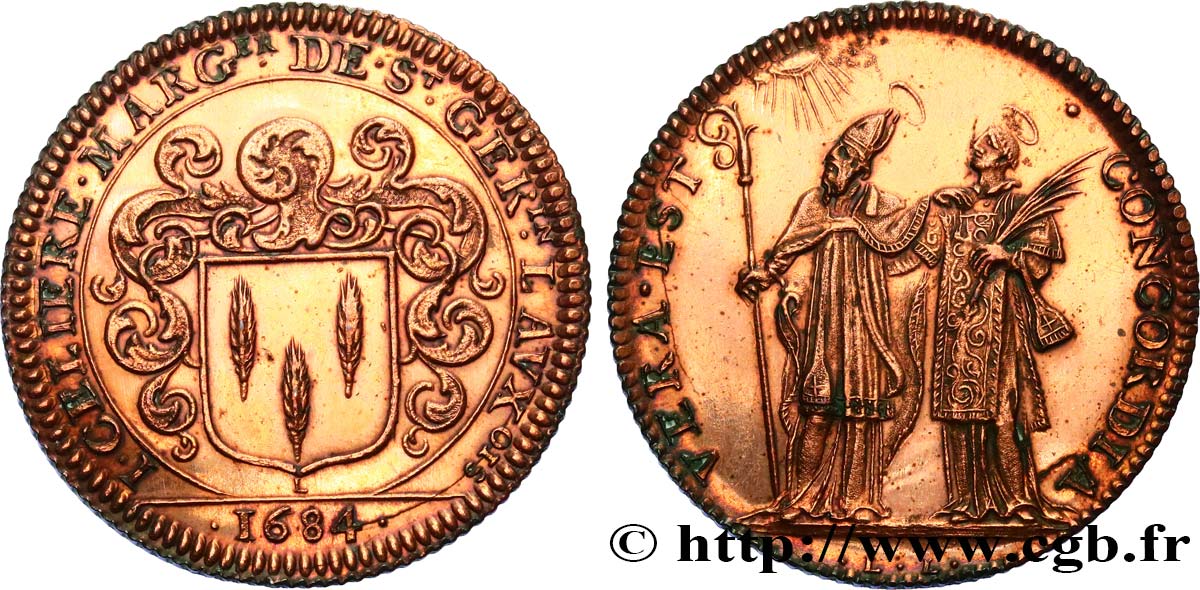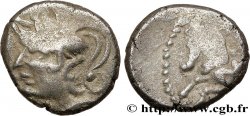fjt_688948 - CHURCHES Saint-Germain-L’Auxerrois 1684
50.00 €
Menge
In den Warenkorb

Type : Saint-Germain-L’Auxerrois
Datum: 1684
Metall : Kupfer
Durchmesser : 28 mm
Stempelstellung : 12 h.
Gewicht : 8,38 g.
Rand cannelée
Punze : sans poinçon
Kommentare zum Erhaltungszustand:
nettoyé
N° im Nachschlagewerk :
Vorderseite
Titulatur der Vorderseite I CELLIERE MARGER DE ST GERIN LAVXOIS ; À L'EXERGUE : 1684.
Beschreibung Vorderseite Armes de J. Cellière.
Rückseite
Titulatur der Rückseite VERA EST CONCORDIA.
Beschreibung Rückseite Saint Germain et un diacre martyr.
Übersetzung der Rückseite La concorde est réelle.
Kommentare
Refrappe indiscutable. Nous n’avons jamais eu ce jeton en frappe originale.
L'église Saint Germain l'Auxerrois est situé sur la place du Louvre. Fondée vers la fin du VIIe siècle sur un sanctuaire mérovingien, elle fut saccagée par les Normands et reconstruite par Robert II le Pieux en 1010. Elle a ensuite été agrandie ou reconstruite à de nombreuses reprises : la tour romane est du XIIe s., le chœur et le portail sont du XIIIe s., le porche et la nef sont du XVe s. Au XVIe s., l'installation des Valois au Louvre fait de Saint-Germain une église royale. Quelques événements s'y produisirent : les cloches de saint-Germain donnèrent le signal de la Saint-Barthélemy le 24 août 1572 ; le 14 février 1831 l'église est mise à sac suite à une messe célébrée par les légitimistes pour l'anniversaire du duc de Berry ; enfin, chaque année, le 21 janvier, les royalistes y célèbrent une messe en souvenir de la mort de Louis XVI.
Undisputed re-strike. We have never had this token in its original strike. The church of Saint Germain l'Auxerrois is located on the Place du Louvre. Founded towards the end of the 7th century on a Merovingian sanctuary, it was sacked by the Normans and rebuilt by Robert II the Pious in 1010. It was then enlarged or rebuilt on numerous occasions: the Romanesque tower is from the 12th century, the choir and the portal are from the 13th century, the porch and the nave are from the 15th century. In the 16th century, the installation of the Valois at the Louvre made Saint-Germain a royal church. Several events took place there: the bells of Saint-Germain gave the signal for Saint-Barthélemy's Day on August 24, 1572; On February 14, 1831, the church was ransacked following a mass celebrated by the Legitimists for the birthday of the Duke of Berry; finally, every year on January 21, the royalists celebrate a mass there in memory of the death of Louis XVI.
L'église Saint Germain l'Auxerrois est situé sur la place du Louvre. Fondée vers la fin du VIIe siècle sur un sanctuaire mérovingien, elle fut saccagée par les Normands et reconstruite par Robert II le Pieux en 1010. Elle a ensuite été agrandie ou reconstruite à de nombreuses reprises : la tour romane est du XIIe s., le chœur et le portail sont du XIIIe s., le porche et la nef sont du XVe s. Au XVIe s., l'installation des Valois au Louvre fait de Saint-Germain une église royale. Quelques événements s'y produisirent : les cloches de saint-Germain donnèrent le signal de la Saint-Barthélemy le 24 août 1572 ; le 14 février 1831 l'église est mise à sac suite à une messe célébrée par les légitimistes pour l'anniversaire du duc de Berry ; enfin, chaque année, le 21 janvier, les royalistes y célèbrent une messe en souvenir de la mort de Louis XVI.
Undisputed re-strike. We have never had this token in its original strike. The church of Saint Germain l'Auxerrois is located on the Place du Louvre. Founded towards the end of the 7th century on a Merovingian sanctuary, it was sacked by the Normans and rebuilt by Robert II the Pious in 1010. It was then enlarged or rebuilt on numerous occasions: the Romanesque tower is from the 12th century, the choir and the portal are from the 13th century, the porch and the nave are from the 15th century. In the 16th century, the installation of the Valois at the Louvre made Saint-Germain a royal church. Several events took place there: the bells of Saint-Germain gave the signal for Saint-Barthélemy's Day on August 24, 1572; On February 14, 1831, the church was ransacked following a mass celebrated by the Legitimists for the birthday of the Duke of Berry; finally, every year on January 21, the royalists celebrate a mass there in memory of the death of Louis XVI.








 Berichten über einen Fehler
Berichten über einen Fehler Die Seite drucken
Die Seite drucken Teilen meiner Auswahl
Teilen meiner Auswahl Stellen Sie eine Frage
Stellen Sie eine Frage Einlieferung/Verkauf
Einlieferung/Verkauf
 Details
Details















